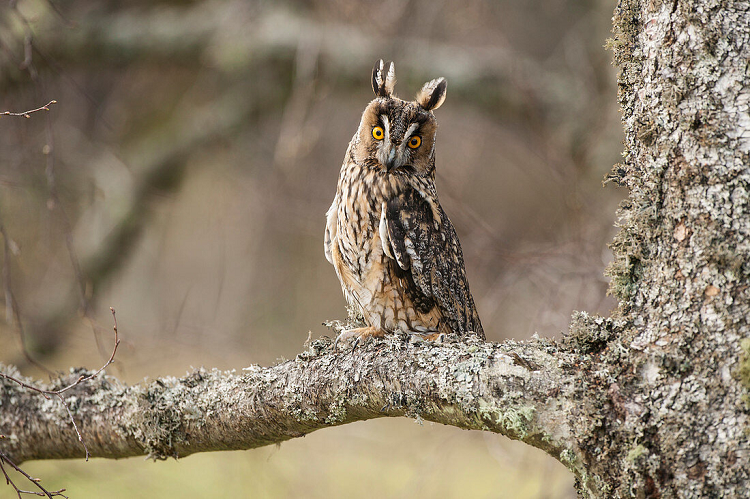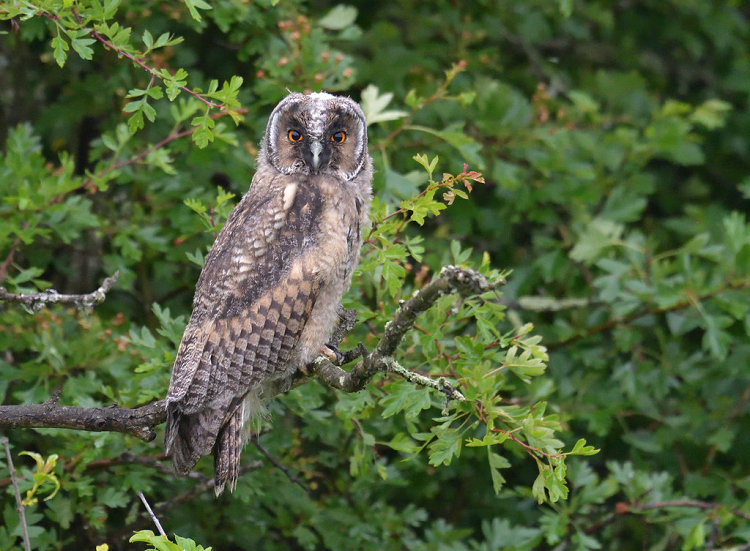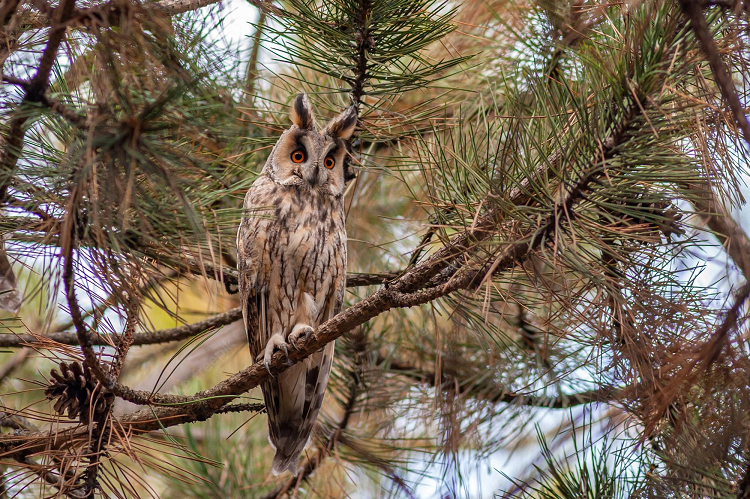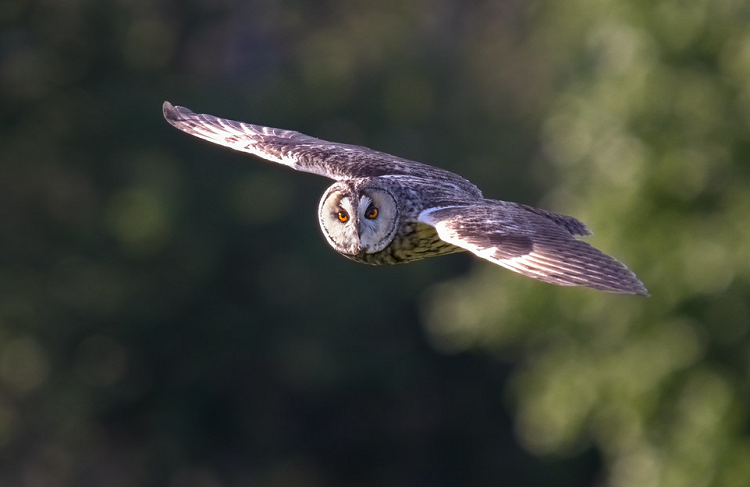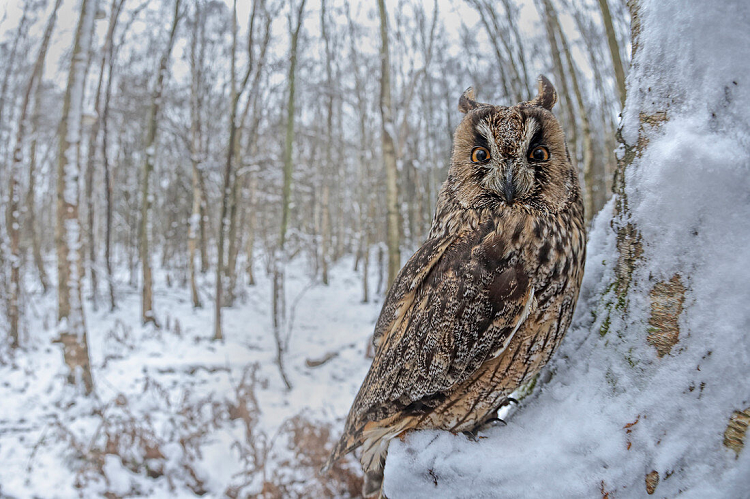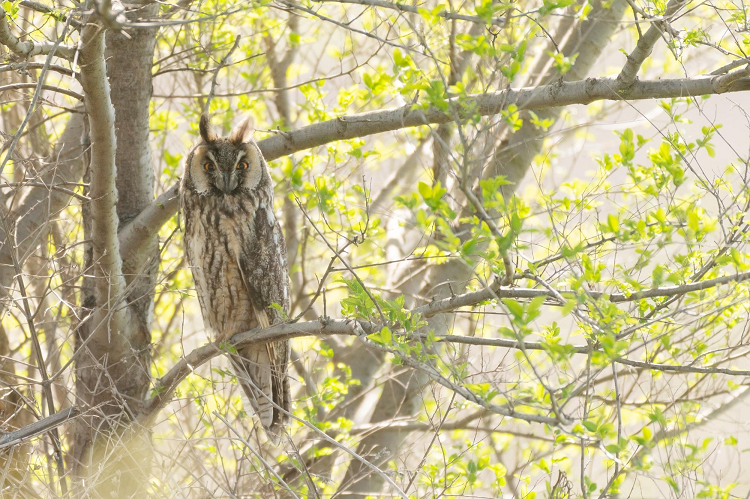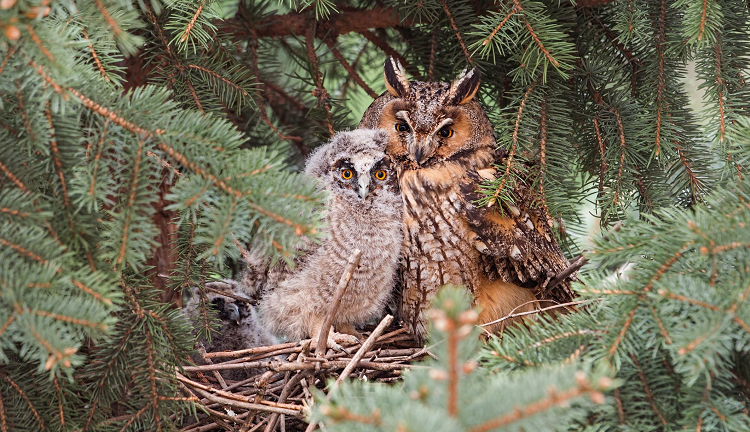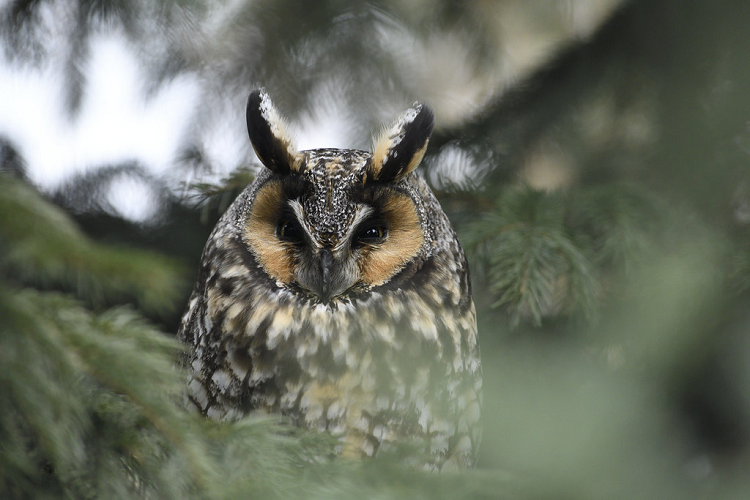- Common Woodpeckers in Missouri Guide - September 13, 2023
- Iconic Birds of New Mexico Guide - September 13, 2023
- Red-breasted Sapsucker Guide (Sphyrapicus ruber) - February 27, 2023
While fairly common throughout their range, Long-eared Owls are seldom seen or heard. Unlike the Great Horned Owls and Barn Owls which perch out in the open and make themselves known with loud, frequent vocalizations, Long-eared Owls prefer to stay quietly out of sight.
They are most often seen in winter when they sometimes roost in groups of up to 100 owls. I’ll never forget stumbling upon a trio of sleeping Long-eared Owls in a mesquite thicket while birding in the desert.
Getting a look at these remarkable and beautifully-patterned owls with their characteristic long ears is always a treat!
But how do you find one? Keep reading to learn how to identify, listen for, and locate these secretive owls!
Taxonomy
Long-eared Owls are members of the order Strigiformes, which contains all of the world’s owl species in its two families: Tytonidae and Strigidae. Long-eared Owls are members of the family Strigidae – known as the “typical owls” or “true owls” – which includes 230 species in its 24 genera.
The Long-eared Owl is one of nine species in the genus Asio. Owls of the genus Asio are collectively referred to as “eared owls,” as all members have ear tufts, though they vary in size from species to species.
Asio owls are medium-sized birds with slight builds, round facial disks, and relatively long wings. They are found throughout the world but not in Australia.
Long-eared Owls are also called northern long-eared owls, cat owls, and lesser horned owls. Their Latin name’s specific epithet, otus, is ancient Greek for “small, eared owl.”
Carl Linnaeus, the Swedish botanist most famous for being the father of modern taxonomy, first described the Long-eared Owl in 1758. Artist and naturalist John James Audubon also documented the species in his famous “The Birds of America” book.
Taxonomy At a Glance
- Kingdom: Animalia
- Phylum: Chordata
- Class: Aves
- Order: Strigiformes
- Family: Strigidae
- Genus: Asio
- Species: Asio otus
How to Identify the Long-eared Owl
At first glance, Long-eared Owls look like Great Horned Owls in shape and coloration but are much smaller and have a more surprised expression.
Adults
Adult Long-eared Owls are medium-sized owls. They stand a little over a foot tall, but are slender and weigh less than nine ounces. As their name suggests, they have distinctive long ear tufts, which are held straight up and are set close together on the top of their heads, giving them an elongated appearance.
The ear tuft feathers are dark-colored on the front but pale when viewed from behind.
Long-eared Owls have round facial disks outlined by a thin black line. Disk feathers often have a rusty tinge, and may be bright orange in some populations.
They have vertical black stripes that extend through their dark yellow to orange eyes and white “eyebrows” and “mustaches” – all of these features combining to give them a surprised expression. Their bills are dark gray to black in color.
Like most owls, Long-eared Owls are cryptically colored. Their plumage is dark brown to gray with some tawny areas on their backs and heads and is heavily mottled with black streaks and spots.
Their undersides are cream-colored but feature large streaks and cross-hatching, often creating the impression of uniform pale rectangles on their chests. The tops of their tail feathers feature five to seven dark horizontal bars between the base and tip. Their legs and feet are covered in pale buffy feathers.
In flight, Long-eared Owls appear to float buoyantly due to their two-to-three-foot wingspans and light bodies. They fly slowly, often hovering and gliding, giving the impression of a giant moth. When flying, Long-eared Owls hold their ear tufts flat to their heads.
As with most owl species, the females are slightly larger than the males. Females also have darker and more heavily mottled plumage.
Immature Birds
Newly hatched nestlings are covered in thick white down. Slighter older owlets have a coat of fluffy, dense gray down, have a dark “V” marking between their eyes, and have black faces with piercing yellow eyes. Their ear tufts are either lacking or are much smaller than those of their adult counterparts.
Juvenile Long-eared Owls look very similar to adults but have more barring on their tail feathers. When observed in the fall, their flight feathers also appear much fresher and lack the wear often seen on the feathers of adults.
Subspecies
There are four subspecies of the Long-eared Owl, two of which occur in North America.
Asio otus wilsonianus is the most widespread subspecies in North America. These owls average larger and feature a bright orange facial disk, yellow eyes, and more distinctive plumage markings overall.
A. otus tuftsi occurs throughout western North America from western Canada south to northwestern Mexico. It is smaller and paler with more gray in its plumage.
A. otus otus occurs throughout Eurasia and in northern Africa. It is a paler version of A. otus wilsonianus, with this lack of color being especially noticeable in the facial disk.
A. otus canariensis is found only on the Canary Islands. It is smaller but more heavily mottled than the other subspecies.
Similar Species
The Long-eared Owl is unmistakable throughout most of its range. It is most often confused with the Great Horned Owl and Short-eared Owl, which both share much of its distribution.
Long-eared Owls are much smaller than Great Horned Owls. Great Horned Owls have white throats and lack the vertical black stripes on the face. They also have ear tufts that stick out to the sides of their heads at an angle rather than straight up.
The closely-related Short-eared Owl has much smaller ear tufts, although when in flight both species hold their ear tufts flat to the head which makes identifying flying birds a challenge.
Long-eared Owls have more distinctive barring near the tips of their wings when viewed from below while Short-eared Owls have mostly pale, unmarked underwings punctuated by dark tips.
Short-eared Owls are paler overall. They are also crepuscular – that is, most active at dawn and dusk – and prefer more open habitats than Long-eared Owls.
Long-eared Owl Vocalizations and Sounds
Long-eared Owls are mostly silent outside of the breeding season and are much less vocal than other owls. Their hoots and calls are also less noticeable. Listen for them on still, moonlit nights between mid-March and June.
Advertisement Hooting
When seeking a mate, a male Long-eared Owl perches in a tall tree and issues a series of soft, slightly upslurred hoots that sound like “hoop, hoop, hoop, hoop,” with each “hoop” punctuated by a two to four second pause.
Hoot series may contain anywhere from 10 to 200 “hoops” and may be heard up to one mile away. Males may start the series with a few deeper hoots.
Check out this video of a male Long-eared Owl hooting:
A female Long-eared Owl may answer his song with her own higher-pitched, nasally hoots that sound like “she-oof!” and “whoof whoof whoof.”
Owing to their smaller and less-developed voice boxes, female vocalizations are higher in pitch and can only be heard at close-range. Females only call to answer males during courtship, during nest selection, and when begging for food just before incubation.
Unlike many other owls, Long-eared Owls do not actively patrol or defend a foraging territory. They do, however, guard their nests and males become aggravated when a rival male hoots nearby.
Other Sounds
Long-eared Owls have around 23 different vocalizations.
Both male and female Long-eared Owls issue an alarm call of nasally high-pitched barks that sound like “yip-yip” or “oh-wack, oh-wack, oh-wack.” They may also squeak, make cat-like “meows,” or produce a quiet, drawn-out moan. Both males and females may perform wing claps that sound like cracking whips during courtship.
If the nest is disturbed, both males and females will issue an aggravated, metallic, high-pitched series of “what-what-what-what”s. When threatened, all owls will hiss and clack their bills.
Begging owlets produce a grating, high-pitched sound reminiscent of a rusty gate hinge swinging open.
Where Does the Long-eared Owl Live?
Long-eared Owls are found in temperate zones of the Northern Hemisphere from North America to Japan. Within their range, they prefer open areas for foraging bordered by dense trees for cover.
Range
Long-eared Owls have a Holarctic distribution, meaning they are found in Europe, Asia, North America, and in northern Africa.
In Eurasia, they occur throughout Scandinavia and most of mainland Europe, east to north and central China, northern Korea, and Japan, and south to the Himalayas. They are also found in northern Africa, on the Azores, and on the Canary Islands.
In North America, they occur north to southern Canada and south to northern Mexico. Long-eared Owls are found throughout the United States but are rare in the southeastern states.
Northernmost populations are migratory and move to the southernmost parts of their range in fall.
Habitat
Long-eared Owls require large, open areas for foraging and areas of dense vegetation for roosting and nesting. They avoid large areas of unbroken forest and vast open areas without cover.
Grasslands and open fields bordered by forests, coniferous and mixed woodlands with clearings, swamps and bogs near stands of poplars, willows, and alders, open taiga forests, oak woodland, ponderosa pine forests, mountain forests with meadows, deserts, and riparian forests are all prime habitats for Long-eared Owls.
They will also take up residence in gardens, parks, cemeteries, and fruit tree orchards.
In winter, Long-eared Owls seek out densely foliated areas – preferably small stands of coniferous trees – for roosting. Mesquite thickets, willow stands, and cottonwood groves are also used.
Long-eared Owl Migration
Many populations of Long-eared Owls consist of year-round residents, but they do not hold conventional territories and move around quite a bit to locate prey. This tendency has earned them the title of “nomadic” rather than residential in most areas.
Populations of Long-eared Owls in the northernmost part of the range are long-distance migrants, often traveling to the southernmost parts of the range in fall and winter to escape heavy snow. North American Long-eared Owls may breed in southern Canada and migrate to northern Mexico for the winter.
Long-eared Owl Diet and Feeding
Long-eared Owls are primarily specialist feeders focused on small rodents, typically voles, but may become opportunistic feeders when rodents are scarce.
Rodents
Rodents, specifically voles, make up most of the Long-eared Owl’s diet. They will also take other locally abundant rodents, including deer mice, kangaroo rats, and pocket gophers.
Other Animals
When rodents are less abundant, Long-eared Owls may feed on other small mammals including shrews, bats, chipmunks, young rabbits, squirrels, and weasels. They will also feed on frogs, snakes, lizards, large insects like beetles and crickets, and spiders.
Long-eared Owls will occasionally feed on birds, often out of desperation. Small birds of open habitats, like blackbirds, are most frequently taken, but young kestrels and other small species of owls, like the Eastern Screech Owl and Boreal Owl, have been captured. In urban areas, Long-eared Owls may feed heavily on House Sparrows.
While extremely rare, Long-eared Owls have been observed feeding on carrion.
Most of their preferred prey weighs two ounces or less, with the largest animal taken being a 1.8-pound juvenile black-tailed jackrabbit.
Long-eared Owl Breeding
The Long-eared Owl breeding season starts between early March and mid-April, depending on latitude, and extends through late June. Compared to other owl species, they breed later in the season.
Courtship
A male Long-eared Owl begins courtship by perching in a tree near preferred habitat and issuing his long hoot series to attract a mate. An interested female will approach him and answer his hoots with her own more nasally and high-pitched version.
The male will then perform an elaborate series of aerial flight displays, zooming around in a zig-zag pattern above potential nesting sites, combining deep wing beats with glides, and occasionally performing a series of up to 20 wing claps that sound like cracking whips. Females may also perform display flights with wing claps, but far less frequently.
If the female deems his chosen nest site acceptable, mating will occur – usually at the nest site. The male flutters his wings and tilts his body just before copulation.
Long-eared Owls are typically monogamous but will remate if their partner dies. On rare occasions, a single male has been observed with multiple female partners. The bonding process starts in late winter, often while pairs are at a communal roost. Existing pairs will “renew their vows” each spring.
Nesting
Male Long-eared Owls scout for potential nest sites each year. Like most owls, they do not construct their own nests, instead looking for sites that are already prepared.
Old stick nests in coniferous trees four to 30 feet off the ground are preferred, typically the nests of Common Ravens, American Crows, Black-billed Magpies, and various species of hawks. Mistletoe “brooms” and squirrel nests are also used. On occasion, Long-eared Owls will even commandeer an active crow’s nest.
When searching for nest sites, Long-eared Owls prefer nests in thick forests or stands of trees for added protection.
When such sites are not available, they will use large saguaro cactuses, nest boxes with open fronts, raised baskets, tree cavities, cliff ledges, or even the ground. When nesting on the ground, they seek covered locations at the base of a tree or below a shrub.
Because they are not territorial, Long-eared Owls may nest in accidental colonies where nest sites occur close together with several pairs raising young in close proximity.
Eggs
Female Long-eared Owls lay two to 10 eggs in late March to early May, with four to six being the most common clutch size. Eggs are laid every other day and are smooth, white, and elliptical with fine pits.
The female incubates solo while the male brings her food. Incubation starts with the first egg and takes 25 to 30 days.
Nestlings
Owlets hatch over a period of several days in late April to early June, with the oldest chick being significantly larger than the youngest. At hatch, they are altricial – that is, helpless with closed eyes – and are covered in white down.
The female continues to brood the owlets for their first two weeks of life while the male hunts for his family. She tears prey into smaller pieces and offers it to the owlets. When they are five to seven days old, their eyes open.
By ten days old, they have a new, dense coat of gray down and striping begins to emerge on their chests, though they still lack ear tufts. After two weeks, the female leaves the nest to assist with hunting to feed the hungry owlets.
Young Long-eared Owls develop fast and leave the exposed nest as soon as possible to avoid predators. At just three weeks old, they climb out of the nest and onto surrounding branches, earning them the name “branchers.”
While still clumsy, branchers are able to climb back into the nest tree if they fall using their bills and rapid flaps of their wings to scramble to safety.
At five weeks old, they attempt their first flight. The male continues to feed them until they are 10 to 11 weeks old, at which point they disperse.
Long-eared Owls typically raise one brood per year. When prey is abundant, they may raise a second brood.
Long-eared Owl Population
Globally, Long-eared Owls are fairly common throughout their range and their overall population is considered stable. But their elusive habits and nomadic movements make them a hard species to study.
The International Union for Conservation of Nature (IUCN) estimates a total global population of 2 million to 5.5 million owls and Partners for Flight estimates a global breeding population of 50,000 individuals, with 36% of this total living in the United States and Canada.
However, some populations are declining, primarily due to habitat loss.
Is the Long-eared Owl Endangered?
Currently, the Long-eared Owl is not endangered. The International Union for Conservation of Nature (IUCN) Red List lists the species as having a status of Least Concern, meaning it is not at immediate risk for extinction.
However, the species has experienced significant declines in some parts of its range. It was included on 2016’s State of North American Birds’ Watch List, designated as being at risk of extinction without conservation efforts. Across all Christmas Bird Count surveys, the species has shown a consistent decline over the past decade. Both Iowa and Illinois now list Long-eared Owls as endangered at the state level, and many other states list it as a species of concern.
Long-eared Owls were once abundant in North America but were heavily hunted in the late 1800s due to superstition and the erroneous belief that they preyed on livestock. In modern times, habitat loss poses the biggest threat to Long-eared Owls.
Unlike its cousin, the more adaptable Short-eared Owl, Long-eared Owls only thrive in the temperate regions of the north. They also require open areas like grasslands and marshes alongside small sections of forests.
Unfortunately, their preferred grasslands, wetlands, forests, and riparian areas are all being eliminated in favor of urban development and agriculture. In the arid west, removing a single grove of trees or riparian forest can be detrimental.
In the absence of suitable foraging and roosting sites, the species vanishes. In southern California, the Long-eared Owl lost 55% of its range due to altered habitats. Yet where its environmental needs are met, Long-eared Owls are abundant. The message is simple: save the habitats, save the species.
Long-eared Owl Habits
Long-eared Owls are fully nocturnal and secretive, typically emerging from their roost sites well after dusk to begin hunting for their preferred rodent prey. The easiest way to find one is to search for their roost sites, as they are seldom heard or seen.
Courtship Hooting
Unlike most owls, Long-eared Owls are not highly territorial. They do not actively patrol the boundaries of their foraging territories like Great Horned Owls, Barred Owls, and Barn Owls do and only hoot during the courtship phase of the breeding season in spring. They are silent most of the year.
If you want to hear Long-eared Owls vocalizing, your best bet is to step outside well after dark on a moonlit, windless night in March or April. Listen for the deep, single-note hoot series of the singing male emanating from a forest or tree grove and the higher-pitched yips of the answering female.
Also, keep your ears perked for the snapping whip cracks of wing claps performed during their courtship display flights. Later in spring and summer, you may also hear the begging owlets, which sound like rusty hinges.
While they are much less aggressive than other owls, the pair may use a variety of tactics to keep you away from their young if you get too close. They will start by chattering harshly to scold you and may feign wing injuries to lure you away. As a last resort, they will fan their wings out to appear larger and may lash out with their talons.
Hunting
Long-eared Owls forage by flying slowly back and forth over open areas, usually only a few feet above the ground, scanning and listening for the small rustlings of their preferred rodent prey. In strong winds, Long-eared Owls may hunt from a perch.
Owing to their large, asymmetrical ear openings, they have superb hearing and can even locate prey in total darkness. Fringed flight feathers with fuzzy surfaces also muffle the sound of their travel, allowing them to fly silently.
Once a target is located, the owl swoops down and grabs it with its talons, killing it with a bite to the base of the skull. Most prey is small and is swallowed whole on-site or carried back to the nest. A small, fur-filled cylindrical pellet is coughed up a few hours later.
Long-eared Owls have also been known to circle shrubs and trees to flush roosting birds, but this is usually performed out of desperation when rodent prey is unavailable.
Long-eared Owls mainly hunt from dusk to an hour before dawn, but, rarely, you may see one hunting in the daytime – usually when they are feeding a large brood of hungry young. Any owl out in the day is quickly mobbed by songbirds and crows, so keep an eye out for this ruckus and you may find a disgruntled Long-eared Owl.
Roosting
At dawn, Long-eared Owls seek out a sheltered area in dense vegetation in which to rest. They show a strong preference for dense trees, especially conifers, standing in a small grove rather than solitarily. Cedars are a favorite, as the trunks are fully concealed. Cottonwoods, junipers, mesquite thickets, and willow stands are also used.
During the winter, 10 to 100 Long-eared Owls may roost communally for added protection from predators – and also because a good roost is hard to come by.
Check every grove of trees surrounded by open area, scanning the ground for elongated, fur-filled gray pellets and whitewash from droppings, and you may be rewarded with several sleeping Long-eared Owls.
When approached at the roost, a Long-eared Owl will first adopt the “tall-thin” posture in an attempt to camouflage itself. It will flatten its feathers as much as possible while drawing itself – including its facial disk and ear tufts – up to its maximum height.
On occasion, it will draw a wing across its chest to further break up the outline of its body. It closes its eyes to slits, sometimes opening one at a time to track your movement. “Tall-thin” owls are remarkably hard to see – often looking just like a broken twig or branch.
If you get too close, the owl may fly away. Avoid flushing roosting owls as this exposes them to predators like diurnal birds-of-prey.
Long-eared Owl Predators
Despite being fierce hunters of rodents, Long-eared Owls are also at risk of becoming prey themselves due to their small statures, exposed nests, and tendency of hunting in the open.
The biggest threat to a Long-eared Owl is any larger owl it shares the night and prime hunting locales with. In Europe, Eurasian Eagle-Owls are their top predator while Great Horned Owls are their main predator in North America.
Other owls, like Barred Owls, Ural Owls, Tawny Owls, and, rarely, Short-eared Owls and Spotted Owls may also attack the smaller Long-eared Owl.
Other birds-of-prey – especially diurnal accipiters that specialize in hunting in forested environments such as Northern Goshawks and Cooper’s Hawks – also pose a threat, especially to hapless fledglings and roosting adults.
Peregrine Falcons, Red-tailed Hawks, Red-shouldered Hawks, Golden Eagles, and Bald Eagles will also take a Long-eared Owl if the opportunity arises.
Pine martens, North American porcupines, bull-snakes, and corvids (crows, ravens, magpies, and jays) will prey on eggs and nestlings as will raccoons, which are also capable of killing the female sitting on the nest.
Other threats to Long-eared Owls are pesticide and rodenticide use, intentional killings due to superstitious beliefs, and collisions with cars.
Note: Avoid using poisoned bait traps to kill mice and rats. Long-eared Owls feed on poisoned rodents and the toxins accumulate in their bodies, which can eventually lead to paralysis and death. They also feed the meat to their young which can be lethal to them.
Long-eared Owl Lifespan
Most young Long-eared Owls do not survive to adulthood. The first year of life is especially challenging, as they must successfully find and kill prey while avoiding predators. If they survive, Long-eared Owls can live fairly long lives.
The oldest documented wild Long-eared Owl was at least 12 years and one month old. Another wild owl was estimated to be at least 15 years old. In captivity, Long-eared Owls have been known to live up to 28 years.
FAQs
Answer: While they look similar at first glance, Great Horned Owls and Long-eared Owls are actually very different from one another. Great Horned Owls are much larger and heavier – a Long-eared Owl stands about half as tall but weighs less than nine ounces while a Great Horned Owl weighs over five pounds!
There are also some key differences in plumage. Great Horned Owls have ear tufts that project out of the sides of their heads at an angle while the ear tufts of Long-eared Owls stick straight up from the tops of their heads.
Long-eared Owls also have dark vertical stripes running through their eyes and heavily mottled chests. Great Horned Owls, meanwhile, have white throat patches and lack these other markings.
Great Horned Owls are also very territorial and aggressive, hooting to defend their territories year-round while Long-eared Owls are secretive and quiet and do not defend territories.
Answer: While they roost communally and sometimes nest near other owl pairs, Long-eared Owls are not technically social birds. They are simply more tolerant of each other, owing largely to the fact that they are less territorial than other owl species.
Answer: Long-eared Owls may seem big because of their ear tufts, but they are actually very slight and light, weighing less than nine ounces.
Their preferred prey are small rodents like voles that weigh less than two ounces. The biggest animal taken by a Long-eared Owl was a young jackrabbit that weighed less than two pounds.
By comparison, the smallest cat weighs over eight pounds and chihuahuas, one of the smallest dog breeds, weigh four pounds and up. A Long-eared Owl could only successfully prey on a newborn kitten or a newborn puppy of a small dog breed. They also hunt in open areas, so the likelihood of this happening is extremely low.
Answer: Long-eared Owls are fully nocturnal. They are not active during the day if they can help it! You may see one hunting during the day during the late spring or summer while pairs are feeding hungry young, or out of desperation after a recent snowfall.
Migrating owls may also be observed in the daytime, especially along the coasts. Any owl active during the day will be mercilessly mobbed by songbirds and crows and is at risk of being seen by a diurnal raptor.
Answer: Long-eared Owls exhibit a strong preference for coniferous trees like pines, cedars, and junipers. Conifers are usually denser, and the trunks are fully or partially concealed by foliage.
Long-eared Owls like dark, protected places to roost and nest, often sleeping close to the trunk. They also like cottonwoods, mesquites, and willow thickets.
Answer: Long-eared Owls require open areas to hunt as well as dense woods to roost in. If you live near a field or pasture, keep some large trees on your property to provide roosting and nesting sites. You can also offer open-fronted nest boxes and elevated baskets or platforms as nest sites.
Research Citations
Books
- Alderfer, J., et al. (2006). Complete Birds of North America (2nd Edition). National Geographic Society.
- Baicich, P.J. & Harrison, C.J.O. (2005). Nests, Eggs, and Nestlings of North American Birds (2nd Edition). Princeton University Press.
- Mikkola, H. (2014). Owls of the World: A Photographic Guide. (2nd Edition). Firefly Books.
- Kaufman, K. (1996). Lives of North American Birds (1st Edition). Houghton Mifflin Company.
- Sibley, D.A. (2014). The Sibley Guide to Birds (2nd Edition). Alfred A. Knopf, Inc.
- Sibley, D.A. (2001). The Sibley Guide to Bird Life and Behavior (1st Edition). Alfred A. Knopf, Inc.
Online
Looking for more interesting readings? Check out:


